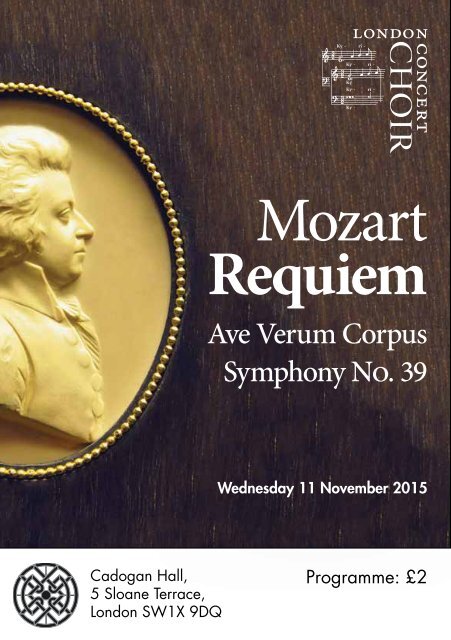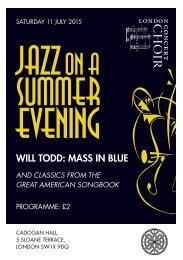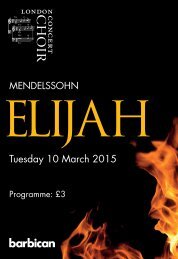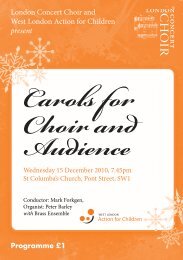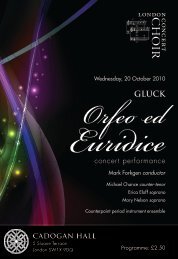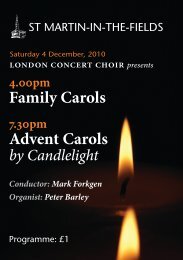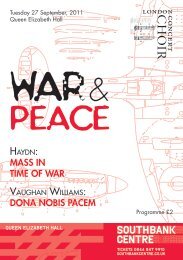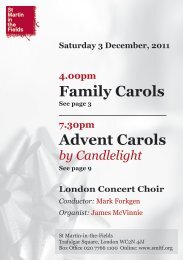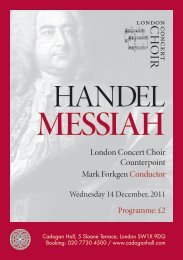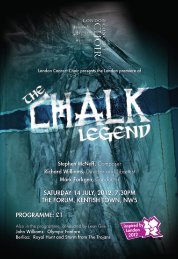11 November, 2015: Mozart Requiem
- No tags were found...
You also want an ePaper? Increase the reach of your titles
YUMPU automatically turns print PDFs into web optimized ePapers that Google loves.
<strong>Mozart</strong><br />
<strong>Requiem</strong><br />
Ave Verum Corpus<br />
Symphony No. 39<br />
Wednesday <strong>11</strong> <strong>November</strong> <strong>2015</strong><br />
Cadogan Hall,<br />
5 Sloane Terrace,<br />
London SW1X 9DQ<br />
Programme: £2
WELCOME TO CADOGAN HALL<br />
In the interests of your comfort and safety, please note the following:<br />
• Latecomers will only be admitted to the auditorium during a suitable<br />
pause in the performance.<br />
• Cadogan Hall is a totally non-smoking building.<br />
• Glasses, bottles and food are not allowed in the auditorium.<br />
• Photography, and the use of any video or audio recording equipment,<br />
is forbidden.<br />
• Mobiles, Pagers and Watches: please ensure that you switch off your<br />
mobile phone and pager, and deactivate any digital alarm on your<br />
watch before the performance begins.<br />
• First Aid: Please ask a Steward if you require assistance.<br />
Thank you for your co-operation. We hope you enjoy the performance.<br />
______________________________________________________________________________________<br />
Programme notes © Sabine Köllmann <strong>2015</strong><br />
Programme designed by Stephen Rickett and edited by Eleanor Cowie<br />
London Concert Choir - A company limited by guarantee, incorporated in England<br />
with registered number 3220578 and registered charity number 1057242<br />
Registered Office 7 Ildersly Grove, Dulwich, London SE21 8EU
Wednesday <strong>11</strong> <strong>November</strong> <strong>2015</strong><br />
Cadogan Hall<br />
<strong>Mozart</strong>:<br />
Ave Verum Corpus<br />
Symphony No. 39<br />
INTERVAL<br />
<strong>Requiem</strong><br />
London Concert Choir<br />
London <strong>Mozart</strong> Players<br />
Mark Forkgen conductor<br />
Jennifer France soprano<br />
Susan Legg mezzo soprano<br />
Nicholas Hurndall Smith tenor<br />
Michael Bundy bass baritone
Wolfgang<br />
Amadeus<br />
<strong>Mozart</strong><br />
(1756-1791)<br />
Tonight’s performance brings together three of <strong>Mozart</strong>’s late works: Symphony<br />
No. 39 in E flat major, the first of his final three symphonies, all composed in a<br />
couple of months over the summer of 1788; Ave verum Corpus, a motet written<br />
for the feast of Corpus Christi in June 1791; and his last work, a <strong>Requiem</strong><br />
Mass, which <strong>Mozart</strong> was unable to finish, having fallen ill with a fever in<br />
<strong>November</strong> 1791. Confined to bed, he continued work on the <strong>Requiem</strong> until his<br />
death in the early hours of 5th December, at only thirty-five years of age.<br />
These are not late works in the sense of representing the culmination and endpoint<br />
of a composer’s musical development. They show <strong>Mozart</strong> at his most<br />
innovative, combining the traditions of the past with new ideas that would change<br />
the course of music. In the last years of his short life, <strong>Mozart</strong> not only ‘excelled<br />
in virtually every genre and style’ (The Oxford Companion to Music); he took<br />
the possibilities of symphonic writing to a new level, pointing ahead to the<br />
Romantic era; and he developed a style of sacred music that expressed at once<br />
devotion and humanity, thus opening the door to its use in the concert hall<br />
as well as in the liturgical setting.<br />
Ave verum Corpus, K618<br />
<strong>Mozart</strong> composed this motet for four-part chorus, strings and organ in June<br />
1791 at the request of Anton Stoll, the local organist and choirmaster in the<br />
small spa town of Baden, not far from Vienna, where <strong>Mozart</strong>’s wife Constanze<br />
spent the last weeks of her sixth pregnancy. In gratitude to Stoll, who looked<br />
after his wife while <strong>Mozart</strong> was going back and forth to Vienna, the composer<br />
set the fourteenth-century Eucharistic hymn Ave verum Corpus (Hail, true<br />
Body) to music, to be performed on the feast of Corpus Christi.
A musical miniature of only forty-six bars, the motet is famed for being<br />
one of the most perfect, yet simple expressions of devotion ever composed.<br />
Unadorned and easily understood, the subtle harmonic shifts in the writing<br />
perfectly respond to the meaning of the text, such as the achingly beautiful<br />
chromaticisms underlining the crucial words ‘immolatum’ (offered in sacrifice)<br />
and ‘perforatum’ (pierced). The final ‘In mortis examine’, the plea to let Christ’s<br />
death be transformed into salvation in our own hour of death, is repeated a<br />
second time, with a short moment of intense anxiety, before returning to the<br />
reassuring home key of D major.<br />
Ave verum Corpus, natum de Maria Virgine:<br />
Vere passum immolatum<br />
in cruce pro homine:<br />
Cuius latus perforatum<br />
unda fluxit et sanguine,<br />
Esto nobis praegustatum in mortis examine.<br />
Hail, true Body, born of the Virgin Mary,<br />
Who truly suffered and was<br />
sacrificed on the Cross for mankind.<br />
From whose pierced side<br />
flowed the water and the blood:<br />
Be for us a foretaste in the trial of death.<br />
Symphony No. 39 in E flat major, K543<br />
It is not known what made <strong>Mozart</strong> compose his last three symphonies in such a<br />
very short period of time over the summer of 1788. Written in quick succession,<br />
yet completely different in character and instrumentation, the symphonies<br />
No. 39 in E flat major, No. 40 in G minor, and No. 41, the ‘Jupiter’ Symphony in<br />
C major, have given rise to much speculation.<br />
Were they meant as a series, to be played consecutively, as some performances<br />
have suggested; or perhaps even as a unity, without a pause, as in a muchdiscussed<br />
recent recording? The fact that the first of these symphonies, No. 39,<br />
is the only one with a grand overture-like opening whereas No. 41, the last one,<br />
ends with a grand finale that is lacking in the other two symphonies suggests<br />
this possibility.<br />
We may speculate about <strong>Mozart</strong>’s intentions, but the fact remains that there is no<br />
record of the purpose or occasion for which he composed the three symphonies,
nor how he intended them to be played and whether they were ever performed<br />
in his lifetime (although he did revise No. 40 to include clarinets). The seductive<br />
idea of <strong>Mozart</strong> composing these works purpose-free, as a legacy for posterity or,<br />
even better, as his ‘appeal to eternity’ (to quote Alfred Einstein), is among the<br />
myths surrounding the composer’s final years.<br />
<strong>Mozart</strong>’s last three symphonies explore the possibilities of symphonic writing to<br />
an extent hitherto unknown. With great freedom he displays his compositional<br />
virtuosity and his superb ability to fuse craft and affect, employing his technical<br />
mastery to achieve an extraordinary breadth and depth of expression. <strong>Mozart</strong><br />
moves away from the traditional style galant – elegant, light, intended to<br />
entertain and delight – to something grander, more difficult and demanding,<br />
while at the same time showing off his ability to integrate traditional and new<br />
tendencies: he combines the delicacy and intimacy of chamber music with more<br />
expansive, dramatic gestures and complex structures.<br />
Symphony No. 39 illustrates this new development: solemnity and gravitas<br />
are combined with wit and playfulness; restrained elegance with boisterous<br />
joyfulness. <strong>Mozart</strong> chooses the key of E flat major and complements the<br />
full, warm sound of this key with an orchestra of strings, wind instruments<br />
including bassoons and horns, trumpets and timpani. Instead of using oboes<br />
he creates a new orchestral sound by giving an important role to the clarinet,<br />
a relatively recent instrument.<br />
The key of E flat major also has masonic associations: the three flats correspond<br />
to the importance of the number three in masonic symbolism. <strong>Mozart</strong> composed<br />
a number of occasional works for the Freemasons in this key which would also<br />
become the home key of his opera The Magic Flute. ‘His masonic music’, we read<br />
in The Oxford Companion to Music, ‘has a distinctive tone, solemn yet exalted<br />
and often joyous’ – perhaps representing the triumph of light, that is, the values<br />
of the Enlightenment.<br />
The symphony opens overture-like with a big dramatic gesture. Fanfares and<br />
timpani create a solemn and imposing mood. Agile downward-moving scales<br />
in the strings turn at some point into grating harmonic dissonances that would
have challenged the expectations of an audience used to the easy-listening style<br />
of most eighteenth-century symphonies.<br />
This stirring, turbulent beginning leads to a surprisingly serene Allegro whose<br />
graceful lyricism is nonetheless punctuated by trumpets and drums, and ends<br />
with a joyful statement. Calmness and energy are also contrasted in the slow<br />
movement: its reassuring A flat major serenity, occasionally undermined by<br />
darker modes, is disturbed by sudden outbursts in unexpected keys. What Grove<br />
calls truly ‘remarkable enharmonic writing’ seemed unnecessarily difficult,<br />
inappropriate and ‘unstylish’ to the first critics – a sure sign that <strong>Mozart</strong> was<br />
pushing the boundaries of symphonic writing.<br />
This is also visible in the third movement where the Minuet, often a minor<br />
element of a symphony, is surprisingly weighty, with added trumpets and<br />
timpani. It imitates the heavy rhythm of a ‘Ländler’, a rustic dance. <strong>Mozart</strong>’s<br />
experience as an opera composer who brought together elements of the sublime<br />
with popular comic opera is on display in the Trio where he reworks a charming<br />
tune derived from a popular drinking song into an inspired dialogue of two<br />
clarinets playing in different registers.<br />
The final Allegro bursts with joyful energy and playfulness. A simple theme<br />
tune, based on an upward- and downward-moving scale, goes through giddying<br />
modifications, never losing its impetus. In this exhilarating final movement<br />
<strong>Mozart</strong> is closest to his mentor and fatherly friend Haydn, who was one of the<br />
greatest admirers of his work. A seemingly never-ending whirlwind of variations<br />
and echoes drives the Allegro not to a grand finale but to a witty close where, in<br />
a throw-away gesture, the basic theme tune is played once again and echoed for<br />
a last time, as if adding an exclamation mark at the end.<br />
INTERVAL – 20 Minutes
<strong>Requiem</strong>, K626<br />
Many legends based on half-truths, common misconceptions, or purely fictional<br />
accounts surround the <strong>Requiem</strong>, <strong>Mozart</strong>’s last work which he left uncompleted<br />
at his death in December 1791. A number of factors have contributed to the<br />
extraordinary grip that this work has had on the public’s imagination for well<br />
over two hundred years: first and foremost the otherworldly beauty of the music<br />
and its deep emotional impact, which cannot be separated from the knowledge<br />
that <strong>Mozart</strong> was writing a Mass for the Dead at a time when he had fallen<br />
seriously ill and in his last few days must have been aware that he was dying.<br />
Add to that the bizarre aura of secrecy surrounding the commissioning of the<br />
work by an anonymous patron who would only communicate via a mysterious<br />
figure, the ominous ‘grey messenger’, who appeared at unexpected points in<br />
<strong>Mozart</strong>’s last months reminding him of his commitment, and you have all the<br />
ingredients for the propagation of romantic stories: conspiracy theories of a<br />
musical genius poisoned by an envious rival (supposedly the Italian composer<br />
Antonio Salieri); controversies surrounding the posthumous completion of<br />
the work; falsified letters to state <strong>Mozart</strong>’s premonitions of death and his clear<br />
understanding that he was writing his own Funeral Mass; exaggerated accounts<br />
that he had fallen out of favour with the musical establishment and was<br />
impoverished; the misunderstanding that <strong>Mozart</strong>’s burial in a common grave<br />
represented a pauper’s funeral, and false reports that there were no mourners<br />
present when the composer was laid to rest, an injustice to which the heavens<br />
responded with a mighty snowstorm...<br />
It is just too tempting a story to stick to the sober truth of the sad premature<br />
death of a young man, a unique musical genius who was extremely busy<br />
working on a huge array of projects, struggling to provide a living for his<br />
family while at the same time composing music that pushed the boundaries<br />
of the public’s expectations. <strong>Mozart</strong> disregarded his own health while caring<br />
for that of his wife, who had to deal with six pregnancies in the eight years of<br />
their marriage, of which only two children survived. The youngest son, Franz<br />
Xaver Wolfgang, was only four months old by the time his father died. <strong>Mozart</strong>’s
friends and patrons not only arranged a dignified funeral, they also made sure<br />
that the <strong>Requiem</strong> Mass in its unfinished form was performed at a memorial<br />
service in Vienna on 10th December 1791, five days after <strong>Mozart</strong>’s death. This<br />
was organized by Emmanuel Schikaneder, librettist of The Magic Flute, and took<br />
place in the parish church of the Hofburg, as was fitting for a court composer.<br />
But the temptation to create a fictional story of destitution, abandonment, envy<br />
and poisoning out of the already quite extraordinary sequence of events giving<br />
rise to the <strong>Requiem</strong> has spanned centuries: it started in 1830 with the Russian<br />
writer Alexander Pushkin’s play <strong>Mozart</strong> and Salieri, which became the basis of<br />
Nikolai Rimsky-Korsakov’s 1897 opera of the same name. Peter Schaffer’s play<br />
of 1979, elaborating on the plot of Salieri poisoning <strong>Mozart</strong> while the latter was<br />
feverishly trying to finish his <strong>Requiem</strong>, was turned into the award-winning film<br />
Amadeus (1984). Director Miloš Forman used <strong>Mozart</strong>’s sublime music to great<br />
effect, creating some connections between images and music that are not easy<br />
to forget. But, as one would expect of good cinema, the film’s focus is on an<br />
intriguing story, not historical accuracy.<br />
The anonymous patron who commissioned a <strong>Requiem</strong> Mass from <strong>Mozart</strong> in<br />
the summer of 1791 was Count Franz von Walsegg-Stuppach, whose young<br />
wife had died in February of that year. It was not the first time that the Count<br />
had commissioned a piece of music from an established composer under<br />
the condition of anonymity. He would then pass off the music as his own to<br />
his friends at private performances. These circumstances only came to light<br />
years after <strong>Mozart</strong>’s death, when his widow Constanze pleaded with the<br />
Count to release the original score that he had received from her. Walsegg<br />
had written out a copy in his own hand, identifying himself as the composer<br />
on the title page.<br />
<strong>Mozart</strong> accepted the commission at a point when he was far too busy to<br />
start on the <strong>Requiem</strong> straight away: in the summer of 1791 he was working<br />
on The Magic Flute, which was to have its premiere on 30th September in<br />
Vienna. At the same time he received another, very important and lucrative<br />
commission to compose an opera for the coronation of Emperor Leopold II as
King of Bohemia on 6th September in Prague. <strong>Mozart</strong> wrote La clemenza di Tito<br />
in the shortest of times, partly on the coach to Prague where he stayed for the<br />
two weeks running up to the premiere. On his return from what must have been<br />
an exhausting journey he continued work on The Magic Flute in preparation<br />
for its premiere. It was probably not until October that he started work on the<br />
<strong>Requiem</strong>. He was simultaneously finishing the Clarinet Concerto (K622) for his<br />
friend Anton Stadler, which was premiered on 16th October, and composing<br />
a masonic cantata (K623, the last work he catalogued in his own register of<br />
works) that he conducted on 18th <strong>November</strong> 1791.<br />
At the heart of <strong>Mozart</strong>’s <strong>Requiem</strong> is the four-part vocal writing. Whether in a<br />
homophonic texture as in the Dies irae and Rex tremendae, a contrapuntal<br />
structure as in the <strong>Requiem</strong> aeternam, or in a fugue such as the Kyrie and the<br />
‘Quam olim Abrahae’ section, <strong>Mozart</strong>’s Mass for the Dead speaks mainly through<br />
the human voice.<br />
The composer was well-acquainted with the great traditions of choral writing<br />
established by Bach and Handel. The influence of Handel can be heard not only<br />
in some melodic lines, but also in <strong>Mozart</strong>’s highly accomplished fugal writing<br />
where lyrical, chamber music-like passages such as the quartet in the Recordare<br />
are followed by great dramatic outbursts in the choral fugues. On the surface,<br />
the music is driven by the same impetus that characterizes Handel’s<br />
choral works; yet the underlying sadness, particularly in the woodwind, lends<br />
a different quality to <strong>Mozart</strong>’s music.<br />
As in the symphony heard earlier, <strong>Mozart</strong> modifies the orchestral sound<br />
to suit his intentions: by excluding higher-pitched instruments such as<br />
flutes and oboes from the orchestral line-up he achieves a different colour,<br />
avoiding anything harsh or overly bright. The ensemble of basset-horns,<br />
bassoons, trumpets, trombones, timpani and strings makes for a dark sound<br />
which intensifies the sombre mood of the <strong>Requiem</strong> Mass. This is particularly<br />
expressive in the Introitus where the extraordinarily beautiful opening
phrase builds in intensity until the weighty entry of the voices, beginning with<br />
the basses through to the sopranos.<br />
The Introitus is the only part of the <strong>Requiem</strong> that <strong>Mozart</strong> left fully scored. For<br />
the following Kyrie, Sequentia and Offertorium he wrote out the vocal parts<br />
and outlined the orchestral parts in form of a figured bass, a short-hand way<br />
of indicating the harmonies. The trombone part at the beginning of the Tuba<br />
mirum is also his original composition. Anecdotal evidence suggests that the<br />
last thing <strong>Mozart</strong> did on his deathbed was sounding out the timpani part of<br />
the <strong>Requiem</strong>. The last notes he ever wrote were the initial eight bars of the<br />
Lacrimosa. It is impossible to listen to that heartbreaking and at the same time<br />
incredibly beautiful music without hearing – and feeling – the immense sadness<br />
and regret of a man dying in his prime, having to leave a great work unfinished.<br />
It is surely significant that he chose to postpone writing the Lacrimosa and<br />
finished the two parts of the Offertorium first. Only then did he go back to<br />
the opening of the Lacrimosa which gradually builds tension from the weeping<br />
heard in the strings to the resurrection of the dead and their slow ascent to<br />
face God’s judgment with trepidation (‘judicandus homo reus’). The feeling<br />
<strong>Mozart</strong> poured into those eight bars gives them an otherworldly quality. It is not<br />
surprising that his pupil Joseph Eybler, who was first approached by Constanze<br />
<strong>Mozart</strong> to finish the <strong>Requiem</strong> after her husband’s death, broke off with his<br />
attempt at exactly that point. It seems he did not feel capable of going beyond<br />
these last notes that <strong>Mozart</strong> had written on the threshold of death.<br />
Constanze was desperate to find someone who would finish the <strong>Requiem</strong> so<br />
that she could hand over the completed work to the anonymous patron. Eybler,<br />
of whom <strong>Mozart</strong> had thought well, filled out the orchestration in the parts that<br />
his master had written down. But when he felt unable to go on, Constanze<br />
approached Franz Xaver Süssmayr, another of <strong>Mozart</strong>’s pupils, who had<br />
accompanied him to Prague to work on the recitatives in La clemenza di Tito.<br />
Both Eybler and Süssmayr had paid regular visits to <strong>Mozart</strong> on his sickbed and<br />
were thus familiar with the work in progress. How much of his concept for<br />
the whole work <strong>Mozart</strong> had conveyed to them on these occasions is a matter
of speculation. But it is well-known that the composer had not thought much<br />
of Süssmayr’s abilities, calling him a ‘blockhead’. Yet Süssmayr had no qualms<br />
about finishing his teacher’s work. He received <strong>Mozart</strong>’s original score with<br />
Eybler’s additions and copied out his own version, using some of the work that<br />
Eybler had done. In addition, Constanze provided him with sketches and scraps<br />
of paper with <strong>Mozart</strong>’s ideas. Süssmayr finished the Lacrimosa but this left him<br />
with three entire movements, the Sanctus, Benedictus and Agnus Dei, which<br />
<strong>Mozart</strong> had not even begun work on.<br />
It must have been a daunting task, and musicians and critics have been arguing<br />
about the quality and authenticity of these movements ever since the 1820s<br />
when the so-called ‘<strong>Requiem</strong> controversy’ broke out. It seems likely that<br />
Süssmayr was not a composer able to execute the complex structural links and<br />
cross-references between movements that musicologists now believe <strong>Mozart</strong><br />
had planned for the whole work. The beauty of Süssmayr’s movements lies in<br />
the simple devotion that they express. They are not able to emulate the power of<br />
<strong>Mozart</strong>’s fugues, his daring juxtaposition of contrasts such as in the Confutatis,<br />
or his superb word painting as in the Dies irae and the Rex tremendae.<br />
In the final Communio Süssmayr decided to reuse <strong>Mozart</strong>’s music for the<br />
Introitus and Kyrie. Whether this was <strong>Mozart</strong>’s own idea, as Constanze claimed,<br />
is not documented. It was in her interest to convince the patron – and later the<br />
publisher – that the entire work was her husband’s. The finished manuscript was<br />
delivered to Count Walsegg in February 1792. He copied the score in his hand,<br />
adding his own name onto the title page, and directed his first performance of<br />
the <strong>Requiem</strong> in a liturgy in December 1793. Unbeknown to him, the completed<br />
work had already been performed from another existing copy in January of that<br />
year in Vienna, in a concert organized by Baron van Swieten for the benefit of<br />
Constanze <strong>Mozart</strong> and her children.<br />
Tonight’s performance relies on what has become the standard version of the<br />
<strong>Requiem</strong> with Süssmayr’s completions and additions. In its entirety it is a<br />
profoundly moving work that speaks to us about the transient nature of human<br />
life. Deeply devotional, it expresses trust in salvation, but also human feelings
of fear of the unknown. <strong>Mozart</strong>’s unique blend of traditional compositional<br />
modes with a forward-looking ethos shines through the whole work. The key of<br />
D minor conveys the solemn wish for eternal rest, but also the terror of the day<br />
of wrath. Trust and fear lie close together. <strong>Mozart</strong> ends the plea for God’s mercy<br />
in the Kyrie eleison with an open fifth which leaves it unresolved and leads<br />
straight into the frightening setting of the Dies irae. The repetition of the Kyrie<br />
music in the final ‘Cum sanctis’ fugue has the effect that the whole <strong>Requiem</strong><br />
ends without a final resolution – perhaps a fitting symbol of a creative life<br />
abruptly cut short.<br />
Text of <strong>Requiem</strong><br />
I. INTROITUS<br />
<strong>Requiem</strong> (Chorus and Soprano solo)<br />
<strong>Requiem</strong> aeternam dona eis Domine:<br />
et lux perpetua luceat eis.<br />
Te decet hymnus Deus in Sion; et tibi<br />
reddetur votum in Jerusalem.<br />
Exaudi orationem meam; ad te<br />
omnis caro veniet.<br />
<strong>Requiem</strong> aeternam dona eis Domine:<br />
et lux perpetua luceat eis.<br />
II. KYRIE (Chorus)<br />
Kyrie eleison<br />
Christe eleison<br />
Kyrie eleison.<br />
III. SEQUENTIA<br />
1. Dies irae (Chorus)<br />
Dies irae, dies illa,<br />
Solvet saeclum in favilla,<br />
Teste David cum Sibylla.<br />
Quantus tremor est futurus,<br />
Quando judex est venturus;<br />
Cuncta stricte discussurus!<br />
Grant them eternal rest, O Lord,<br />
and let perpetual light shine upon them.<br />
Thou art praised, O God, in Zion; and unto Thee<br />
shall the vow be performed in Jerusalem.<br />
Hear my prayer; unto Thee shall<br />
all flesh come.<br />
Grant them eternal rest, O Lord,<br />
and let perpetual light shine upon them.<br />
Lord, have mercy<br />
Christ, have mercy<br />
Lord, have mercy.<br />
Day of wrath, that day<br />
shall dissolve the world in ashes;<br />
so spake David and the Sybil.<br />
How great shall be the trembling<br />
when the Judge shall come,<br />
to weigh all things exactly.
2. Tuba mirum (Soloists)<br />
Tuba mirum spargens sonum<br />
per sepulchra regionum,<br />
coget omnes ante thronum.<br />
Mors stupebit et natura,<br />
cum resurget creatura,<br />
judicanti responsura.<br />
Liber scriptus proferetur,<br />
in quo totum continetur,<br />
unde mundus judicetur.<br />
Judex ergo cum sedebit,<br />
quidquid latet apparebit:<br />
nil inultum remanebit.<br />
Quid sum miser tunc dicturus?<br />
Quem patronum rogaturus,<br />
cum vix justus sit securus?<br />
3. Rex tremendae (Chorus)<br />
Rex tremendae majestatis,<br />
qui salvandos salvas gratis,<br />
salva me fons pietatis.<br />
4. Recordare (Soloists)<br />
Recordare Jesu pie,<br />
quod sum cause tuae viae,<br />
ne me perdas illa die.<br />
Quaerens me sedisti lassus,<br />
redemisti crucem passus;<br />
tantus labor non sit cassus.<br />
Juste Judex ultionis,<br />
donum fac remissionis<br />
ante diem rationis.<br />
Ingemisco tanquam reus,<br />
culpa rubet vultus meus,<br />
supplicanti parce Deus.<br />
Qui Mariam absolvisti,<br />
et latronem exaudisti,<br />
mihi quoque spem dedisti.<br />
Preces meae non sunt dignae:<br />
sed tu bonus fac benigne,<br />
ne perenni cremer igne.<br />
Inter oves locum praesta,<br />
et ab hoedis me sequestra,<br />
statuens in parte dextra.<br />
The trumpet spreading wondrous sound<br />
Through the tombs of every land,<br />
Summons all before the throne.<br />
Death and nature will be astounded,<br />
When all creation rises again<br />
to answer to the Judge.<br />
The book of words shall be brought forth,<br />
in which everything is contained<br />
whereby the world is to be judged.<br />
Therefore when the Judge is seated,<br />
whatever is hidden will appear,<br />
nothing shall remain unpunished.<br />
What shall I, a wretch, say then?<br />
To which protector shall I appeal,<br />
while even the righteous are hardly safe?<br />
King of tremendous majesty,<br />
Who freely saves those deserving it,<br />
Save me, O fount of mercy.<br />
Remember, merciful Jesus,<br />
that I am the reason for Thy journey;<br />
lest Thou lose me on that day.<br />
Seeking me, Thou didst sink down wearily;<br />
Thou hast redeemed me by enduring the cross;<br />
Let not such travail be in vain.<br />
Righteous judge of vengeance,<br />
grant me the gift of absolution<br />
before the day of retribution.<br />
I groan as one guilty,<br />
my face blushes with guilt,<br />
spare the supplicant, O God.<br />
Thou who didst pardon Mary [Magdalen],<br />
and didst listen to the thief,<br />
hast given me hope also.<br />
My prayers are unworthy,<br />
but good Lord, be kind<br />
and let me not burn in eternal fire.<br />
Grant me a place among the sheep,<br />
and separate me from the goats,<br />
setting me at Thy right hand.
5. Confutatis (Chorus)<br />
Confutatis maledictis,<br />
flammis acribus addictis,<br />
voca me cum benedictis.<br />
Oro supplex et acclinis,<br />
cor contritum quasi cinis:<br />
gere curam mei finis.<br />
6. Lacrimosa (Chorus)<br />
Lacrimosa dies illa,<br />
qua resurget ex favilla<br />
judicandus homo reus.<br />
Huic ergo parce Deus.<br />
Pie Jesu Domine<br />
dona eis requiem. Amen<br />
When the wicked are confounded,<br />
and consigned to the bitter flames<br />
call me to be with the blessed.<br />
Kneeling in supplication I pray,<br />
my heart is contrite as ashes,<br />
take into Thy care mine end.<br />
That day will be full of tears,<br />
when from the ashes arises<br />
guilty man to be judged;<br />
Spare him, therefore, O God!<br />
Merciful Lord Jesus,<br />
grant them rest. Amen.<br />
IV. OFFERTORIUM<br />
1. Domine Jesu (Chorus and soloists)<br />
Domine Jesu Christe, Rex gloriae,<br />
libera animas omnium fidelium<br />
defunctorum de poenis inferni,<br />
et de profundo lacu:<br />
libera eas de ore leonis,<br />
ne absorbeat eas tartarus,<br />
ne cadant in obscurum.<br />
Sed signifer sanctus Michael<br />
repraesentet eas in lucem sanctam,<br />
quam olim Abrahae promisisti,<br />
et semini eius.<br />
2. Hostias (Chorus)<br />
Hostias et preces tibi Domine,<br />
laudis offerimus:<br />
Tu suscipe pro animabus illis,<br />
quarum hodie memoriam facimus:<br />
fac eas Domine de morte<br />
transire ad vitam.<br />
Quam olim Abrahae promisisti<br />
et semini eius.<br />
V. SANCTUS (Chorus)<br />
Sanctus, sanctus, sanctus,<br />
Dominus Deus Sabaoth.<br />
Pleni sunt coeli et terra gloria tua.<br />
Osanna in excelsis!<br />
Lord Jesus Christ, King of glory,<br />
deliver the souls of all the faithful<br />
departed from the pains of hell<br />
and from the deep pit:<br />
deliver them from the lion’s mouth,<br />
lest hell swallow them up,<br />
and lest they fall into darkness.<br />
But may the holy standard-bearer, Michael,<br />
lead them into the holy light;<br />
as once Thou didst promise<br />
to Abraham and his seed.<br />
We offer sacrifices and prayers of praise<br />
to Thee, O Lord:<br />
Do Thou receive them on behalf of those souls<br />
whom we commemorate this day:<br />
Grant them, O Lord,<br />
to pass from death unto life.<br />
As once Thou didst promise<br />
to Abraham and his seed.<br />
Holy, holy, holy,<br />
Lord God of hosts.<br />
Heaven and earth are full of Thy glory,<br />
Hosanna in the highest!
VI. BENEDICTUS (Soloists and Chorus)<br />
Benedictus qui venit in nomine Domini.<br />
Osanna in excelsis!<br />
Blessed is He that cometh in the name of the<br />
Lord. Hosanna in the highest!<br />
VII. AGNUS DEI (Chorus)<br />
Agnus Dei, qui tollis peccata mundi,<br />
dona eis requiem.<br />
Agnus Dei, qui tollis peccata mundi,<br />
dona eis requiem.<br />
Agnus Dei, qui tollis peccati mundi,<br />
dona eis requiem sempiternam<br />
Lamb of God, who takest away the sins of the<br />
world, grant them rest.<br />
Lamb of God, who takest away the sins of the<br />
world, grant them rest.<br />
Lamb of God, who takest away the sins of the<br />
world, grant them eternal rest.<br />
VIII. COMMUNIO<br />
Lux aeterna (Soprano solo and Chorus)<br />
Lux aeterna luceat eis Domine.<br />
Cum sanctis tuis in aeternum, quia pius es.<br />
<strong>Requiem</strong> aeternam dona eis Domine;<br />
et lux perpetua luceat eis.<br />
Cum sanctis tuis in aeternum, quia pius es.<br />
May light eternal shine upon them, O Lord.<br />
With Thy saints for ever, for Thou art merciful.<br />
Grant them eternal rest, O Lord,<br />
and let perpetual light shine upon them.<br />
With Thy saints for ever, for Thou art merciful.
Mark Forkgen conductor<br />
Mark Forkgen has been Music Director of London Concert<br />
Choir since 1996. He is also Music Director of Canticum<br />
chamber choir, Principal Conductor and Artistic Advisor<br />
of Kokoro (the Bournemouth Symphony Orchestra’s New<br />
Music Group) and Director of Music at Tonbridge School.<br />
He has conducted major UK orchestras, including the<br />
Royal Philharmonic Orchestra, Orchestra of the Age of<br />
Enlightenment, Bournemouth Symphony Orchestra, City<br />
of London Sinfonia, English Chamber Orchestra, English<br />
Northern Philharmonia and Manchester Camerata, appearing at major venues,<br />
including the Royal Festival Hall, the Barbican and the Royal Albert Hall.<br />
A specialist in the field of choral and contemporary music, Mark has given the first<br />
performances of more than 100 works. He has also conducted stage works with the<br />
Trestle Theatre Company and Britten Sinfonia, and contemporary opera with the<br />
Unicorn Theatre Company and an ensemble from the Philharmonia, at the Linbury<br />
Studio, Royal Opera House, Covent Garden.<br />
Mark’s wide range of conducting also includes performances with Deep Purple for<br />
the Henley Festival and recreating Pink Floyd’s Atom Heart Mother in the Chelsea<br />
Festival. He also enjoys an active life as a pianist, focusing on 20th Century<br />
and contemporary music. His recitals last season covered repertoire by<br />
Stravinsky, Debussy, Messiaen, Bartok, Sir Peter Maxwell Davies, Oliver Knussen<br />
and Thomas Adès.<br />
He has been Conductor and Artistic Advisor for highly acclaimed festivals, including:<br />
Sir Peter Maxwell Davies’ 70th Birthday; Stravinsky, ‘A Festival of Britten’, ‘Music<br />
of the Americas’, ‘Britain since Britten’ and ‘East meets West’. Outside the UK he<br />
has conducted in Denmark, Spain, France, Belgium, Germany, Holland, Eire, the<br />
Czech Republic and Italy (including Handel’s Messiah in Sienna and Israel in Egypt<br />
at the Viterbo Early Music Festival), Bulgaria (concerts broadcast for National TV<br />
and Radio) and Hong Kong.<br />
Last season’s highlights included Sir Peter Maxwell Davies’ Vesalii Icones with the<br />
composer, productions of Cabaret and The Boy Friend, programmes based on<br />
Masters of the Kings’ and Queens’ Music, a project combining the music of Eric<br />
Satie with film, and a highly acclaimed concert including three first performances<br />
at the Cheltenham Festival. Other highlights this Autumn include a programme<br />
based on the theme of ‘Light’ for the Bournemouth Festival, a series inspired by<br />
Shakespeare, the choral music of Howard Blake and, as a pianist, performances of<br />
Shostakovich’s Second Piano Trio with works by Stravinsky and Debussy.
Jennifer France soprano<br />
Winner of the Loveday Song Prize at the 2014 Kathleen<br />
Ferrier Awards, Jennifer France graduated from the Opera<br />
Course at the Royal Academy of Music, where she won<br />
many prizes, including the prestigious Patron’s Award<br />
that resulted in her solo recital debut at the Wigmore Hall,<br />
and was awarded the Principal’s Prize at graduation for<br />
exceptional all-round studentship in Summer 2013. She is<br />
currently studying with Lillian Watson.<br />
For Royal Academy Opera her roles included Héro<br />
Béatrice et Bénédict, Lisetta La vera costanza, Madame Herz Der Schauspieldirektor,<br />
Papagena Die Zauberflöte and Zerbinetta Ariadne auf Naxos. Further engagements<br />
have included Marzelline Fidelio for Garsington Opera at Wormsley and<br />
at the Winterthur Festival, First Niece Peter Grimes for Opera North, Le Feu /<br />
Le Rossignol L’enfant et les sortilèges with the BBC Symphony Orchestra, Marjory<br />
Making Arrangements for Tête-à-Tête Opera and Esmeralda The Bartered Bride for<br />
British Youth Opera.<br />
Jennifer France has an extensive concert repertoire, performing in many venues<br />
across the UK including Royal Albert Hall, St Martin-in-the-Fields, St John’s, Smith<br />
Square, King’s Place, The Sage, Gateshead, and Wigmore Hall. Her recordings<br />
include a recital of songs by Debussy with Malcolm Martineau for Hyperion.<br />
Last season she returned to Opera North as Lauretta Gianni Schicchi and Esmeralda<br />
The Bartered Bride and made debuts with Opera Holland Park as The Controller<br />
Flight and, in concert, with the Hallé, the Oxford Philomusica, Raymond Gubbay Ltd<br />
and the Really Big Chorus.<br />
Current engagements include Dalinda Ariodante and Despina Così fan tutte for<br />
Scottish Opera, Sisamma Le nozze di Figaro for Garsington Opera at Wormsley,<br />
Zerbinetta Ariadne auf Naxos for the Nederlandse Reisopera, returns to the Hallé<br />
and Raymond Gubbay Ltd, her debut with the Israel Camerata and New Year<br />
concerts with the Orchestra of Opera North.
Susan Legg mezzo soprano<br />
Described in The Sunday Times as ‘a lustrous mezzo<br />
soprano’ and now specialising in contemporary song,<br />
lieder and oratorio, Susan regularly broadcasts on radio<br />
and has given recitals at the Wigmore Hall, Purcell Room,<br />
St. John’s, Smith Square and opera galas at St. James’s<br />
Palace and British Embassies in Moscow, Copenhagen,<br />
Lisbon and Stockholm. Oratorios have taken her to Durham,<br />
Chichester and Arundel Cathedrals, Romsey, Dorchester<br />
and Worth Abbeys, and Spitalfields and Cadogan Hall,<br />
London. Operatic engagements included Glyndebourne, Bayreuth, Wexford,<br />
Aldeburgh and the Walton Trust, Ischia. Susan has performed all Elgar’s works,<br />
Bach’s Passions, Verdi and <strong>Mozart</strong> <strong>Requiem</strong>s, Beethoven’s Ninth Symphony and<br />
Missa Solemnis, and toured Handel’s Messiah in Mexico.<br />
Susan’s voice – which legendary mezzo Christa Ludwig described as ‘beautiful …<br />
with a fine coloratura’ – can be heard on many films and award-winning video<br />
games including the number one game Project Cars for composer Stephen Baysted.<br />
An accomplished pianist, Susan recently recorded and co-composed the soundtrack<br />
for the feature film The Impressionists (‘dazzling’ Sydney Arts Guide) and Laurie<br />
Dunkin-Wedd’s musique concrète score Brancusi for solo mezzo and industrial<br />
sounds.<br />
Projects with pianist Ann Martin-Davis encompass commissioned song-cycles from<br />
Graham Fitkin, Howard Skempton and Gabriel Jackson and an International tour<br />
of Mr James’ Garden, celebrating Edward James’s surrealist Mexican garden Las<br />
Pozas. Their CD Heaven-Haven - The Songs of Peter Pope followed a definitive<br />
Lutosławski chamber music recording, described as ‘beautiful and exquisite’ by BBC<br />
Music Magazine.<br />
Susan won the National <strong>Mozart</strong> Singing Competition whilst still a student at the<br />
Royal College of Music and other accolades since completing her training at the<br />
National Opera Studio are: Richard Tauber Schubert Society Prize; Tillett Trust’s<br />
Young Artists’ Platform; Kathleen Ferrier Awards; Belvedere International Singing<br />
Competition, Vienna (finalist); and British representative in the Queen Sonja<br />
International Music Competition, Norway.
Nicholas Hurndall Smith tenor<br />
Nicholas Hurndall Smith studied music at Corpus Christi<br />
College, Oxford, where he was organ scholar, before<br />
deciding to study singing at the Guildhall School of Music<br />
and Drama.<br />
On the concert stage he is a regular soloist for London<br />
Concert Choir, having sung Bach’s Christmas Oratorio<br />
with them at Cadogan Hall and Haydn’s The Seasons in<br />
London and Assisi. He has performed Bach cantatas with<br />
the Academy of Ancient Music, The Fairy Queen with the English Concert, and<br />
Coridon Acis and Galatea for the Gabrieli Consort in the Wigmore Hall. Nicholas<br />
regularly performs Bach cantatas with the Feinstein Ensemble and the London<br />
Bach Singers. He recently made his debut with the viol consort Fretwork in a<br />
recital of Purcell and Dowland.<br />
He is a regular guest soloist with the group Eclipse, bringing music, songs,<br />
dance and legends of the British Isles to venues throughout the UK and<br />
as far afield as Istanbul. His operatic roles include Lurcanio Ariodante<br />
(English Touring Opera), Tamino The Magic Flute and Flute A Midsummer<br />
Night’s Dream (Longborough Festival Opera), Ecclitico Il mondo della luna<br />
(Opera della luna), Normanno Lucia di Lammermoor (Iford Arts) and Sellem<br />
The Rake’s Progress (Opera East).<br />
An established Britten singer, he has sung St Nicolas with the London <strong>Mozart</strong><br />
Players and the English Chamber Orchestra. He has had a long association<br />
with Cumbria Choral Initiative, which combines the choral societies of<br />
Cumbria, and with them has sung Britten’s War <strong>Requiem</strong>, Finzi’s Intimations of<br />
Immortality and Howell’s In Paradisum. He has also sung Britten’s Serenade with<br />
the Haffner Orchestra.<br />
Nicholas is a frequent visitor to Norway and Germany, and in particular<br />
to Schleswig Holstein, returning several times a year for performances of<br />
Schütz’s Weihnachtshistorie, Handel’s Messiah and Bach’s Christmas Oratorio<br />
and Passions. He has been a member of the award-winning solo voice<br />
ensemble I Fagiolini for over twenty years, taking part in their innovative staged<br />
productions of Renaissance and Baroque music theatre works and singing<br />
the title role in Carissimi’s Jonah in the BBC Proms. He also gives regular song<br />
recitals in Germany and throughout the UK.<br />
Nicholas is visiting singing teacher at Sidney Sussex College and Homerton College,<br />
Cambridge. He enjoys adding rock‐climbs to his repertoire. In August 2012 he<br />
completed a traverse of the Matterhorn, raising £10,000 for the charity Leukaemia &<br />
Lymphoma Research.
Michael Bundy bass baritone<br />
Michael R. Bundy, a music graduate of Trinity College,<br />
Cambridge and the Guildhall School of Music and Drama,<br />
has performed widely in diverse genres. He has appeared<br />
as soloist with groups such as The Sixteen, The Orchestra of<br />
the Age of Enlightenment and has a continuing relationship<br />
with the BBC Singers.<br />
His operatic repertoire exceeds forty roles and he has sung<br />
with English National Opera, Kent Opera, Scottish Opera,<br />
the Royal Opera, Mauritius Opera, and the Narodni<br />
Divadlo in Prague. He appeared with Theater Basel in Actus Tragicus and performed<br />
with Opera Restor’d and the Akademie für Alte Musik Berlin in Lampe’s comic opera<br />
The Dragon of Wantley at the Potsdam Festival.<br />
His Oratorio repertoire is catholic, and broadcasts for BBC Radio 3 include<br />
Bonnal’s oratorio Poèmes Franciscains. Work with Trevor Pinnock has included<br />
Bach’s Saint Matthew Passion in Europe, Istanbul and Japan, and he has also<br />
appeared as soloist with Sir John Eliot Gardiner in Berlioz L’Enfance du Christ,<br />
Handel’s Israel in Egypt (both BBC Proms), Bach’s B Minor Mass, Haydn’s Nelson<br />
Mass and the Odes and Masques of Purcell. He broadcast the role of Gobryas<br />
in Handel’s Belshazzar with Robert King and sang Elgar’s Dream of Gerontius in<br />
Ely and Rochester cathedrals, and the Smetana Hall (Prague;) a further<br />
performance was given in the Usher Hall, Edinburgh, as was Mahler’s<br />
Eighth Symphony, also performed at the Royal Albert Hall. Other recent<br />
performances have included Verdi’s <strong>Requiem</strong>, the Passions of J.S. Bach, Rossini’s<br />
Petite Messe... and Brahms’ <strong>Requiem</strong>.<br />
He has issued a series of recordings with Naxos featuring the Mélodies of<br />
Widor, Vierne and Tournemire. A book – Prophets without Honour... discussing<br />
these mélodies, is also available. A further book, Visions of Eternity... dealing<br />
with the choral and operatic works by these same composers, is due for<br />
publication in 2016.<br />
Other commercial recordings include Purcell’s The Fairy Queen, Chausson’s Le Roi<br />
Arthus, Tovey’s The Bride of Dionysus, Lydia Kakabadse’s The Phantom Listeners and<br />
Michael Hurd’s The Widow of Ephesus.<br />
Having premièred works by Hardy, McGuire, McDowall, and also Sharriff’s<br />
opera Golem 13 (in Prague), as well as having broadcast the roles of Olin Britt<br />
(Music Man), Mr. Lindquist (A Little Night Music) for BBC Radio 2, demonstrates that<br />
he is as at home in contemporary music as he is with ‘lighter’ music.
London Concert Choir<br />
London Concert Choir, founded as the Brompton Choral<br />
Society in 1960, now has around 150 members of a wide<br />
range of ages and is notable for its wide-ranging musical<br />
repertoire. With Music Director Mark Forkgen the choir<br />
appears at all the major London concert venues and in<br />
cathedrals and churches in and around the capital, as well as<br />
touring further afield.<br />
In 2014 the choir performed Haydn’s oratorio The Seasons<br />
in the Basilica di San Francesco at Assisi with Southbank<br />
Sinfonia. A performance of Verdi’s <strong>Requiem</strong> with the Augsburg<br />
Basilica Choir in the Royal Festival Hall in 20<strong>11</strong> was followed<br />
by a joint concert at the Augsburg Peace Festival. A tour to<br />
Krakow will take place in July 2016.<br />
LCC celebrated its 50th anniversary in 2010 with two<br />
memorable performances of Britten’s War <strong>Requiem</strong>: at the<br />
Barbican and in Salisbury Cathedral. Among other major<br />
works in earlier seasons have been Beethoven’s Missa<br />
Solemnis with the English Chamber Orchestra and Elgar’s<br />
Dream of Gerontius and Mendelssohn’s Elijah, both with<br />
Southbank Sinfonia.<br />
Performances of Baroque music with Counterpoint<br />
include Handel’s Messiah and Judas Maccabaeus and<br />
Bach’s Christmas Oratorio and St Matthew Passion. On a<br />
smaller scale, the choir has sung unaccompanied church<br />
music by British and Russian composers, and Rossini’s<br />
Petite Messe Solennelle.<br />
Operas in concert performance have ranged from<br />
Gluck’s Orfeo to Gershwin’s Porgy and Bess with the<br />
Royal Philharmonic Orchestra, and the London premiere of<br />
The Chalk Legend by Stephen McNeff. LCC has also<br />
performed Duke Ellington’s Sacred Concert, and Will Todd’s<br />
Mass in Blue as part of a jazz concert. The choir often<br />
gives concerts for charity and has commissioned a number<br />
of new works.<br />
Mark Forkgen<br />
Music Director<br />
James Longford<br />
Principal Accompanist<br />
____________________<br />
Fabyan Evans<br />
Chairman<br />
Barbara Whent<br />
Concert Manager<br />
Katja Pluto<br />
Treasurer<br />
Stephen Rickett<br />
Design and<br />
Communications<br />
Jennifer Greenway<br />
Membership<br />
Eleanor Cowie<br />
Publicity<br />
Simon Livesey<br />
Company Secretary<br />
www.london-concert-choir.org.uk
Members of London Concert Choir<br />
Soprano<br />
Eleanor Austin<br />
Gillian Bibby<br />
Mickey Bowden<br />
Ellie Boyd<br />
Aisling Caroll-Turner<br />
Alison Carpenter<br />
Beatrice Conchado<br />
Amandine Consigny<br />
Eleanor Cowie<br />
Christine Dencer<br />
Gillian Denham<br />
Susan Deville<br />
Emma Dixon<br />
Emily Dresner<br />
Rachel Duffield<br />
Serena Ede<br />
Francesca Ede<br />
Anna Field<br />
Sarah French<br />
Lisa Gardner<br />
Suzanne Gee<br />
Sonja Gray<br />
Jennifer Greenway<br />
Jennifer Hadley<br />
Emma Heath<br />
Ruth Hobbs<br />
Laura Holland<br />
Jennifer Howe<br />
Charlotte Hunt<br />
Christine Ingram<br />
Jane Joyce<br />
Roxana Kashani<br />
Vickie Kelly<br />
Anna Kosicka<br />
Frances Lake<br />
Sarah Lewin<br />
Susanna Lutman<br />
Elsa Martinez<br />
Hannah Mason<br />
Jessica Metcalfe<br />
Adrienne Morgan<br />
Stephanie Moussadis<br />
Margaret Perkins<br />
Olivia Purdy<br />
Jutta Raftery<br />
Ines Schlenker<br />
Frances Shaw<br />
Caroline Sheppard<br />
Imogen Small<br />
Imogen Smith<br />
Teresa Tilden<br />
Natalie Tompkins<br />
Emily Tuite<br />
Francesca Wareing<br />
Janet Wells<br />
Belinda Whittingham<br />
Julie Wilson<br />
Alto<br />
Rachel Adams<br />
Angela Alonso<br />
Fionnuala Barrett<br />
Heide Baumann<br />
Helen Beddall-Smith<br />
Chloe Bridgen<br />
Gesa Brinkmann<br />
Frances Cave<br />
Lucy Charman<br />
Carys Cooper<br />
Deborah Curle<br />
Georgie Day<br />
Kathleen Dormer<br />
Stefanie Ettelt<br />
Alice Everitt<br />
Rebecca Foulkes<br />
Georgina Furr<br />
Annie Gair<br />
Clare Garbett<br />
Anna Garnier<br />
Mary Glanville<br />
Ruth Grychtol<br />
Muriel Hall<br />
Penny Hatfield<br />
Andrea Hegedus<br />
Joan Herbert<br />
Anu Holter<br />
Chrina Jarvis<br />
Chris Joseph<br />
Sabine Köllmann<br />
Joanna Kramer<br />
Katie Kumar<br />
Lorna Lewis<br />
Liz Lowther<br />
Norma MacMillan<br />
Bridget Maidment<br />
Adrienne Mathews<br />
Corinna Matlis<br />
Anna Metcalf<br />
Sophy Miles<br />
Cathy Packe<br />
Judith Paterson<br />
Gillian Perry<br />
Katja Pluto<br />
Dubravka Polic<br />
Agnes Ringa<br />
Theresa Rogers<br />
Pamela Slatter<br />
Tabitha Strydom<br />
Kate Tranter<br />
Mary Varney<br />
Erin Vlasved<br />
Rachel Vroom<br />
Gabriel West<br />
Barbara Whent<br />
June Williams<br />
Nathalie Wilson<br />
Rosie de Saram<br />
Tenor<br />
Andrew Bolan<br />
David Broad<br />
Dave Dosoruth<br />
James Ede<br />
Fabyan Evans<br />
Bram Frankhuijzen<br />
Nicholas Hall<br />
Sam Hansford<br />
Richard Holmes<br />
Carolyn Knight<br />
Ian Leslie<br />
Frances Liew<br />
Ben Martin<br />
Stephen Rickett<br />
Tim Steer<br />
Barry Sterndale-Bennett<br />
Tim Thirlway<br />
Ruth Yeo<br />
Bass<br />
Colin Allies<br />
Peter Banks<br />
Richard Burbury<br />
Mark Chater<br />
Henry Cook<br />
Andrew Cullen<br />
Chris Finch<br />
James Finlay<br />
Richard Gillard<br />
Nigel Grieve<br />
Julian Hall<br />
Nigel Hartnell<br />
Graham Hick<br />
Richard Hughes<br />
Ian Judson<br />
Robert Kealey<br />
Stefan Klaazen<br />
Simon Livesey<br />
Angus Macdonald<br />
Alan Machacek<br />
Alex Morley-Smith<br />
Christopher Powell-<br />
Smith<br />
Morgan Roberts<br />
Desmond Sandford<br />
Anthony Sharp<br />
Ryszard Stepaniuk<br />
William Tilden<br />
Tony Trowles<br />
Philip Vickers<br />
Dai Whittingham
London <strong>Mozart</strong> Players<br />
Founded by Harry Blech in 1949 as the UK’s first chamber orchestra, the London<br />
<strong>Mozart</strong> Players (LMP) has achieved international renown for its outstanding live<br />
performances and CD recordings of the core Classical repertoire. Music Directors<br />
have included Gérard Korsten, Andrew Parrott, Matthias Bamert and Jane<br />
Glover, who grew and developed the orchestra’s strong Classical tradition. The<br />
LMP enjoys connections with Hilary Davan Wetton as Associate Conductor, and<br />
Howard Shelley as Conductor Laureate, and continues to work closely with many<br />
of the world’s finest conductors and soloists, including Tasmin Little and Anthony<br />
Marwood. In <strong>2015</strong> the LMP appointed cellist Laura van der Heijden as its first<br />
Young Artist in Residence.<br />
In addition the LMP also plays an active part in contemporary music, giving many<br />
world premières and commissioning new works, in recent years by composers<br />
including Sir Peter Maxwell Davies, Tarik O’Regan, Sally Beamish, Cecilia<br />
McDowall, Lynne Plowman, Fraser Trainer and Jonathan Dove. In March 20<strong>11</strong><br />
the LMP appointed Roxanna Panufnik as Associate Composer.<br />
The LMP has been committed to providing a platform for sharing the creative arts<br />
with schools and communities for over 25 years. LMP Voyager is an education and<br />
community hub which allows music to inspire, educate and enrich communities<br />
through an extensive programme of work across the UK.<br />
The LMP has a vast programme of work in the community, from visiting daycare<br />
centres and care homes to providing community concerts for elderly and disabled<br />
people. The LMP is associated with Royal Holloway, University of London, Wellington<br />
College, the Portsmouth Grammar School and the Whitgift Foundation Schools<br />
in Croydon. Other ongoing ventures include concert demonstrations in primary<br />
and secondary schools.<br />
Touring is a major part of the orchestra’s schedule, with regular appearances at<br />
festivals and concert series throughout the UK and abroad. Overseas, the LMP<br />
has visited China, Spain, Belgium, France and Germany. Recording has played a<br />
major part in the orchestra’s life for many years. A long relationship with Chandos<br />
includes many recordings of works by Haydn and <strong>Mozart</strong> and an acclaimed<br />
Contemporaries of <strong>Mozart</strong> series numbers over 20 CDs. New Naxos release<br />
Flowers of the Field in collaboration with City of London Choir, Roderick Williams<br />
and Hilary Davan Wetton reached No.1 in the Classical Album Charts.<br />
The LMP enjoys the patronage of HRH The Earl of Wessex. In June 2014 the LMP<br />
began a new and exciting phase in its history, becoming the first chamber orchestra<br />
in the UK to be managed both operationally and artistically by the players.
Music Director<br />
Gérard Korsten<br />
Associate Conductor<br />
Hilary Davan Wetton<br />
Conductor Laureate<br />
Howard Shelley<br />
1st Violins<br />
Simon Blendis<br />
Nicoline Kraamwinkel<br />
Ann Criscuolo<br />
Anna De Bruin<br />
Richard Blayden<br />
Catherine Van de Geest<br />
Thea Spires<br />
2nd Violins<br />
David Angel<br />
Jayne Spencer<br />
Stephen Rouse<br />
Raja Halder<br />
Clare Hayes<br />
Chihiro Ono<br />
Violas<br />
Judith Busbridge<br />
Sophie Renshaw<br />
Michael Posner<br />
Richard Cookson<br />
Cellos<br />
Sebastian Comberti<br />
Julia Desbruslais<br />
Ben Chappell<br />
Julia Graham<br />
Basses<br />
Stacey Watton<br />
Cathy Elliott<br />
Flute<br />
Laura Lucas<br />
Clarinets/Bassett Horns<br />
Anna Hashamoto<br />
Charys Green<br />
Bassoons<br />
Adam MacKenzie<br />
Robert Porter<br />
Organ<br />
James Longford<br />
Horns<br />
Peter Francomb<br />
Martin Grainger<br />
Trumpets<br />
Paul Archibald<br />
Peter Wright<br />
Trombones<br />
Ian White<br />
Jeremy Gough<br />
Ian Fasham<br />
Timpani<br />
Ben Hoffnung
Supporting the Choir<br />
London Concert Choir is committed to high standards and constantly strives to<br />
raise the level of its performances by means of workshops and other special<br />
events. The choir is grateful for the financial contribution of all its supporters in<br />
helping to achieve these aims, and welcomes their active involvement.<br />
LCC Supporters<br />
Sue Blyth, Deborah Bono, Simon Cave, Bill and Bronwen Cook, Angela Cooper,<br />
Dianne Denham, Geoffrey Deville, Karen Evans, John and Judith Greenway,<br />
Jeremy Groom, Nicholas and Maureen Halton, Tim Ingram, Miriam Kramer,<br />
Mark and Liza Loveday, Jill Marx, Janet and Michael Orr, Jennifer Powell Smith,<br />
Michael Shipley, Anthony Smith, Sybil and Nicholas Spence, Ruth Steinholtz,<br />
Alison Stone, Jill Tilden, Susan Wheatley, Anthony Willson<br />
For information on helping the choir to maintain its position as one of the leading<br />
amateur choirs in London via the Supporters’ Scheme, please email:<br />
treasurer@london-concert-choir.org.uk<br />
The choir also offers opportunities for targeted giving and for corporate support<br />
through sponsorship or programme advertising and enquiries should be sent to<br />
the same address.<br />
Life Friends<br />
LCC is delighted to acknowledge the invaluable contribution made by the<br />
following individuals:<br />
Peter Barley, Tim and Patricia Barnes, Anne Clayton, Bill Cook, Mr and Mrs Michael Hunt,<br />
Mark and Liza Loveday, Sue McFadyen, Gregory and Helen Rose, Nicholas Spence<br />
Joining the Choir<br />
London Concert Choir welcomes new members, who are invited to attend a few<br />
rehearsals before an informal audition. If you are interested in joining the choir,<br />
please fill in your details online at www.london-concert-choir.org.uk/joinus<br />
Mailing List<br />
If you would like to receive advance information about our concerts, you can join<br />
the choir’s free mailing list by emailing mailinglist@london-concert-choir.org.uk<br />
The information you provide is subject to the Data Protection Act and as such will<br />
be used exclusively by London Concert Choir.
Conductor: Mark Forkgen<br />
Saturday 28 <strong>November</strong> <strong>2015</strong>, 4.00pm<br />
St Martin-in-the-Fields, Trafalgar Square, WC2<br />
Advent Carols by Candlelight<br />
Thursday 17 and Friday 18 December <strong>2015</strong>, 7.30pm<br />
St Sepulchre’s Church, Holborn Viaduct, EC1<br />
Carols for Choir and Audience<br />
Monday 7 March 2016, 7.30pm<br />
St John’s, Smith Square, SW1<br />
Monteverdi: Vespers of 1610<br />
Wednesday 15 June 2016, 7.30pm<br />
Barbican Hall, Silk Street, EC1<br />
THE JUTLAND CONCERT<br />
Vaughan Williams: A Sea Symphony<br />
Britten: Four Sea Interludes from Peter Grimes<br />
To commemorate the Centenary of the Battle of Jutland<br />
and the lives of all who died at sea during the Great War<br />
and for the benefit of Seafaring Charities<br />
Thursday 14 July 2016, 7.30pm<br />
Holy Trinity Church, Sloane Street, SW1<br />
Hymns to the Virgin
A CONCERT SERIES BY<br />
LONDON MOZART PLAYERS<br />
FOR A<br />
3:30pm<br />
6th DEC <strong>2015</strong><br />
SUNDAY<br />
AFTERNOON<br />
COME & SING<br />
MOZART | REQUIEM IN D MINOR, K 626<br />
Guest Conductor Dominic Peckham<br />
The last concert in the Music for a Sunday Afternoon<br />
series. Join the London <strong>Mozart</strong> Players for ‘Come &<br />
Sing’, a unique community concert that will see choirs<br />
and amateur singers from across London come<br />
together for a unique performance of <strong>Mozart</strong>’s much<br />
loved <strong>Requiem</strong>. Guest soloists include Sinead O’Kelly,<br />
Louise Collett, Warren Gillespie & Ross McInroy. Also<br />
singing alongside the orchestra will be Croydon Bach<br />
and Croydon Philharmonic Choirs.<br />
CALLING ALL SINGERS!<br />
If you would like to participate in singing at this event and sharing the stage with the LMP, please contact<br />
Jenny Brady for more information and to request a registration form: jenny@lmp.org | 020 8686 1996<br />
The participation fee for adults and those not in full-time education is £10. The deadline for applications is<br />
Friday 20th <strong>November</strong>.<br />
Fairfield Halls Box Office: Tickets £12, £5 (under 16s), under 5s go free • www.fairfield.co.uk • Tel: 020 8688 9291


